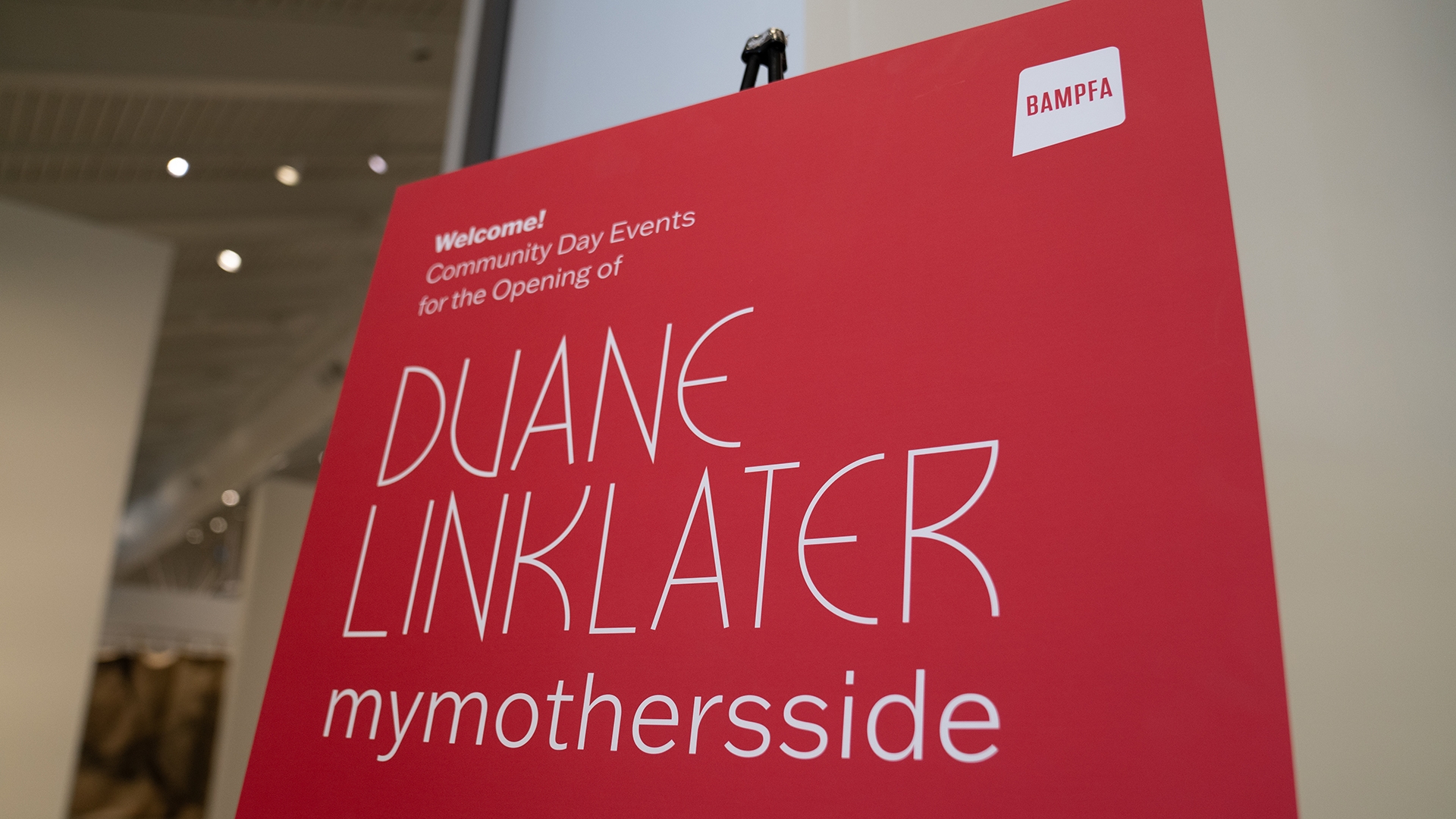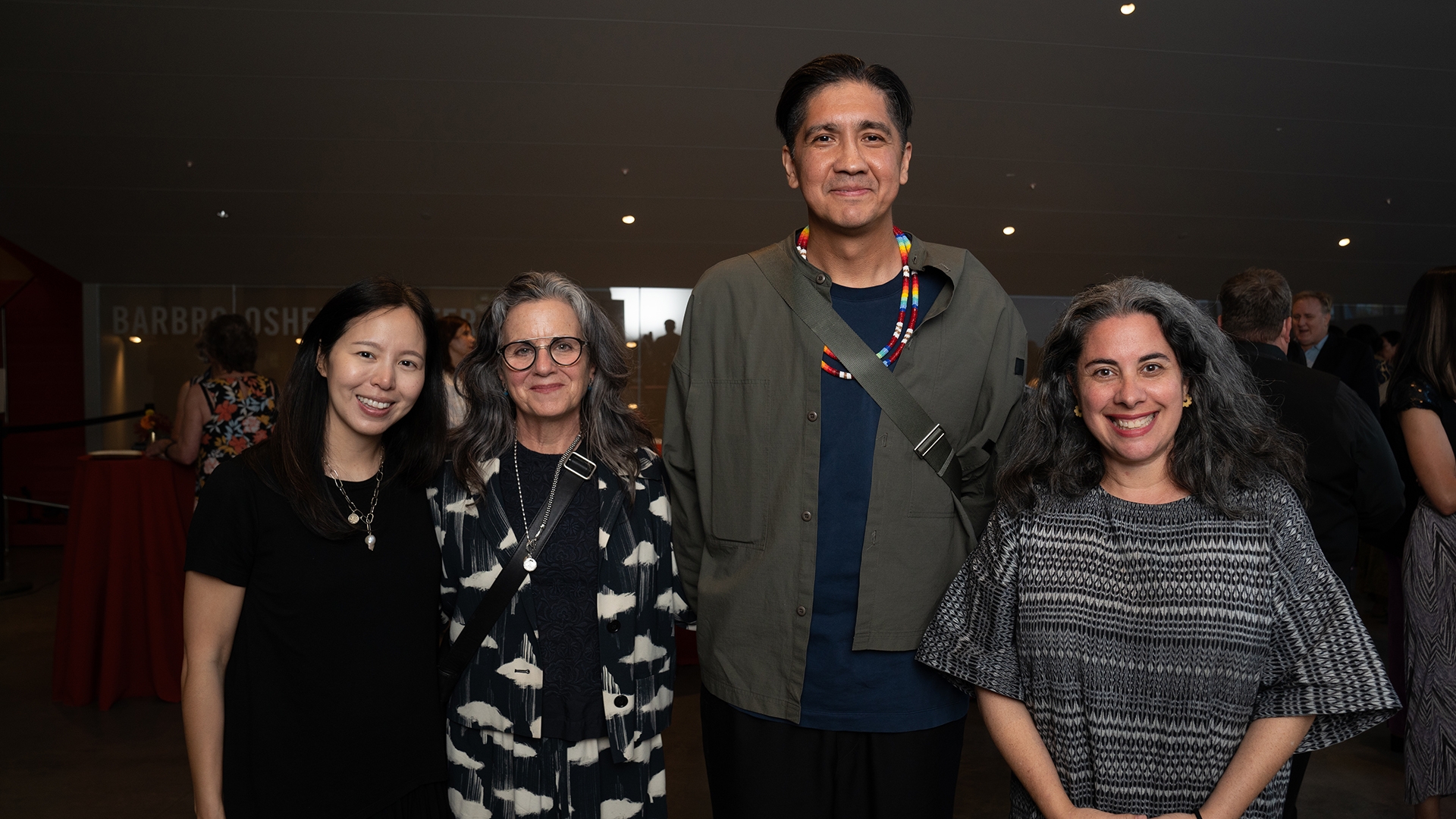‘mymothersside’: A tribute to the knowledge keepers in artist Duane Linklater’s family
Senior curator Victoria Sung, who joined the Berkeley Art Museum and Pacific Film Archive (BAMPFA) in March, talks about working with the Omaskêko Cree artist and how, together, they made the museum a generative space for showing his artwork.
October 27, 2023
The exhibition Duane Linklater: mymothersside opened at the Berkeley Art Museum and Pacific Film Archive (BAMPFA) earlier this month, and brings with it a host of cross-campus collaborations and public programs.
Victoria Sung, who joined BAMPFA in March as the Phyllis C. Wattis Senior Curator, organized the exhibition, a survey of artist Linklater’s practice, which includes painting, sculpture, video, performance and large-scale installations.
In his work, Linklater, who is Omaskêko Cree from Northeastern Ontario, in Canada, explores the contradictions of contemporary Indigenous life within settler systems of knowledge, representation and value. Berkeley News talked with Sung about the responsibilities of a curator, working with artists like Linklater, and how, together, they made the museum a generative space for showing his artwork.
Berkeley News: As a curator, what do you do? What’s most important to keep in mind?

Kelly Sullivan
Victoria Sung: I am a curator of contemporary art, which means that I primarily work with living artists to plan exhibitions and other programs. I’m interested in working with artists whose practices spark dialogue, spur deep thinking and provoke close looking. And along with BAMPFA’s curatorial team, led by chief curator Margot Norton, I’m continually thinking about how our programs might resonate or feel relevant to our audiences. At UC Berkeley, that means making sure our exhibitions can serve as rich platforms for teaching and learning with faculty and students and also contribute to conversations happening in the wider Bay Area, as well as nationally and internationally.
The first exhibition you organized at BAMPFA, Duane Linklater: mymothersside, is now on view in the museum. Can you tell us about the exhibition?
The title, mymothersside, alludes to the importance of matrilineal kinship systems within his Cree heritage, but it also speaks to the personal nature of the exhibition, in that Duane worked on this show following the passing of both his mother and maternal grandmother. The entire show can be seen as a tribute to these and the other women in his life who were and continue to be the knowledge keepers of his family. It is thanks to his grandmother, for example, that Duane learned how to speak and write in Cree, as well as practice other ancestral traditions that are referenced in different artworks.
The exhibition originated at the Frye Art Museum in Seattle and toured to the Museum of Contemporary Art in Chicago, so Berkeley is its final destination. For Duane, an exhibition is a living thing. He’s constantly changing or introducing new works into the mix, and he thinks seriously about the context in which he’s showing his practice. So even though mymothersside has already been presented in two other cities, he’s brought it to life in different ways in Berkeley, and we’re thrilled that we could work closely with him and a number of partners on campus to realize a host of exciting public programs in conjunction with the show.
Can you describe some of the public programming and how it interacts with his work?

Liz Lott
In partnership with the campus’s Arts Research Center (ARC), Tanya Lukin Linklater, who is Duane’s wife, will be leading a series of open rehearsals in early November with dance artists Ivanie Aubin-Malo and Ceinwen Gobert, called Ewako ôma askiy. This then is the earth. They’ll be moving through the exhibition galleries, responding to the cyclical, seasonal, affective and formal qualities of different works in mymothersside. Visitors can drop in at any point to watch the process.
In January, we will be hosting a roundtable conversation focusing on Indigenous knowledge and ways of being, including such topics as language revitalization, food sovereignty and ancestral practices, like basket weaving, with Beth Piatote (Nez Perce), a Berkeley associate professor of English and comparative literature; Carolyn Smith (Karuk), an assistant professor of anthropology at Berkeley; and noted food writer and author Sara Calvosa Olson (Karuk).
In February, we’re hosting a series of poetry readings, again in partnership with the ARC. Led by Indigenous writers Craig Santos Perez (Chamoru), Natalie Diaz (Mojave) and Piatote, the two-day event at BAMPFA will feature readings by 19 poetry fellows, an ekphrastic poetry workshop in the galleries and a headline event with Santos Perez, Diaz and Piatote.
Finally, Duane and his son Tobias, who perform together as the musical project eagles with eyes closed, will close out the exhibition at the end of February with a live performance. The duo will score Modest Livelihood, a silent film on view in the exhibition that follows Duane and fellow artist Brian Jungen on a hunting trip in Dane-zaa Territory in Northern British Columbia. Duane and Tobias will perform in the gallery, and audiences are invited to attend.
What has it been like working with Duane in organizing Duane Linklater: mymothersside?
Duane is one of the most thoughtful artists I’ve worked with. There’s a generosity to his practice, in that he takes the time to really walk you through his process of thinking and making. At the same time, he asks a lot from you as a curator to take seriously the responsibility of showing his work. He’s an artist who is deeply committed to his vision, and often that vision includes interrogating the institutions showing his work.
What did that process look like at BAMPFA?
It’s no secret that UC Berkeley, and the Hearst Museum of Anthropology, in particular, is participating in a long overdue process of returning thousands of ancestral remains, as well as sacred and funerary objects, to Native communities in California.

KLC Fotos
For an artist whose work directly addresses the historical and ongoing extraction, dispossession and erasure of Indigenous peoples in North America, the reality of the university’s decadeslong noncompliance with the Native American Graves Protection and Repatriation Act (NAGPRA) is something that we were grappling with in the months leading up to the exhibition opening. As someone whose family is not indigenous to Northern California, Duane fully recognized the weight of responsibility that comes with showing his work here, and for us that responsibility meant thinking about how we can use our platform as the university art museum to center this issue and advocate for the necessary repatriation.
A big emphasis for Duane during his time in Berkeley was to find ways to meaningfully connect with Native students on campus, which he was able to do both in one-on-one and group settings. He was also keen to make sure that the exhibition is both a critical and welcoming space for them.
Like many institutions, museums have historically been places of exclusion, open to only certain groups of people. How important is it to you to expand who feels welcome in these spaces today?
As a curator of color who believes immensely in the power of telling otherwise untold stories through art and other forms of material culture, I know how important it is to ensure that museums create spaces for diverse audiences, students, community members and anyone who walks through our doors. Making BAMPFA a welcoming and inclusive space is a crucial part of director Julie Rodrigues Widholm’s vision, and it guides our work every single day. There’s nothing I find more rewarding than walking into the galleries and seeing them filled with students and other visitors engaging with the works on view.
Read more about BAMPFA’s exhibition, Duane Linklater: mymothersside.
Learn more about the Arts Research Center’s fall 2023 programming and its visiting artists-in-residence program.











